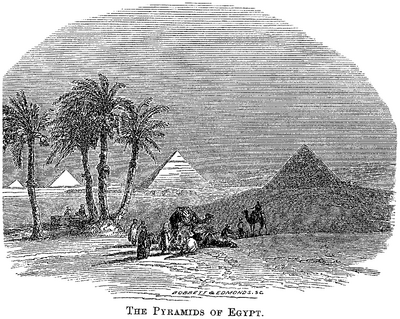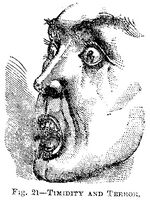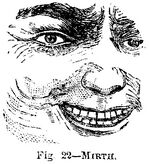The sun's distance and the pyramids
Some of the results of the observations made by astronomers during the recent transit of Venus have already appeared, and they are peculiarly interesting, because of a certain archeological relation. M. Puiseux has communicated to the Academy of Sciences in France the conclusions based upon late observations of the transit at the Island of St. Paul and at Pekin. The solar parallax was given at 8".879, the remarkable feature of which is its exact correspondence with certain dimensions found in the great pyramid in Egypt, and which for a long time has been thought by astronomers and antiquaries to have been founded upon an extensive knowledge of astronomy possessed by the people who built that pyramid. Heretofore, among moderns, the solar distance has been estimated at two and three per cent. more than the recent investigations show it to be, and, of consequence, the dimensions in the pyramid did not closely accord. Now, the correction of the error in our calculation of the sun’s distance shows an almost perfect agreement. The conclusion from this goes to prove the height to which astronomical science had been carried at the period when the pyramids were constructed, whether four thousand years ago—which the Usher chronology asserts,—or from ten to twelve thousand years ago, as is believed to be more nearly in accordance with historical fact. Old readers of the Phrenological may recall an article on the “Pyramids of Egypt,” in which allusion was made to the learning of ancient Egyptians in the departments of engineering and astronomy; but it is not out of place to append the following interesting statements, which we find in the Scientific American:
“Several features in the Egyptian pyramids, especially the large one (that of Cheops), have long been a matter of surprise to scientific visitors; for instance, of having the sides of the square base exactly in the direction of the cardinal points of the compass — north, south, east, and west; of having the long tunnel leading from the side at the mouth obliquely down to the center of the pyramid, inclined under an angle exactly corresponding with the latitude under which the pyramid is placed, so that when looking from this center outward through this long hallway or tunnel, the polar star is always seen. This induced investigators to find more peculiarities having relation to astronomical data, and it was found that the pyramid abounded in these; for instance, the distance and size of the interior chambers, gangways, etc. At every step most curious relations were found, which certainly could not have been the result of accident.
“The solar parallax means the angle under which the earth’s radius is seen from the sun. As we know the correct dimensions of our earth, it becomes a simple geometrical, or, rather, trigonometrical, question to find the distance: it is simply the problem to find the height of a very long triangle, of which the small base and opposite angle at the top are given. This angle at the top is the parallax-is, and if it be 8 seconds and 879 thousands, we have only to find the Sine of this angle, which will be to the Radius as the radius of the earth is to the distance of the sun. For very small angles the Sine is equal to the arc, and we have only to divide 8".879 (or, for simplicity sake, 8".88) into 360 × 60 × 60 = 380 × 3,600=362 × 1,000 = 1,296 × 1,000 = 1,296,000, the number of seconds contained in the whole circumference, and the quotient 145,946 shows the fraction of the circumference corresponding to the Sine of the arc of 8".88, and this is equal to 2 × 3,1415926 ÷ 145946 = 0,00004305145; accepting now the radius of the earth in round numbers as 8.950 miles, we have the proportion that the Sine of the earth's parallax is to the Radius as the radius of the earth is to its distance from the sun, or Sine 8".88 : R = 3,950 : solar distance, or 0.00004305145 : 1 = 3,950 to solar distance, we have therefore only to divide 3,95 by the decimal fraction 0.00004305145, which is equivalent to 3,950,000,000.000 ÷ 4305145 which gives 92,000,000 miles very nearly.
The Pyramids of Egypt
Fig. 20–Malignant
Fig. 21–Timidity and Terror
Fig. 31–Dissipated–Sottish
Fig. 22–Mirth
Sayings of the Press
The diakka. — In an editorial, “The Chicago Tribune” says, “The Diakka are bad spirits. Andrew Jackson Davis has found out all about them. According to his ponderous effusion on the subject, they are the beings who break dishes and tumble around furniture and tell outrageous lies and bring the shades of prominent dead men into disrepute by maliciously personation them. When George Washington sings ‘Hey-diddle-diddle, the cat and the fiddle,’ to a circle of awestruck geese, it is not George Washington, but a Diak (if that is the proper singuar of Jhe tribal name). When Benjamiti Franklin dances a jig and Charles Dickens writes an idiotic story and Keats raps out this wonderous couplet:
You are my queen, |
the Diakka are playing their pranks. These things might be suffered to pass without protest, since such glaring shams are readily delected ; but when the Diakkai carry a pail of dirty water into the yard and tip it over on the week’s wash, as they lately did in Milwaukee, or when they give the furniture in a house the St. Vitus dance at midnight, as they have just done in Sin Francisco, or when they pitched the whole contents of a china closed into one heap of debris, as they did near New Haven, Connecticut, a few years ago, — then it is time to complain. Yet even these evils are not the worst. If a New Orleans burglar is to be believed, he has a spirit in his employ, whom he described as ‘A very devil of a ghost! that will climb up any balcony in the city, crawl through any key-hole, and throw me down all the valuables, without so much as wakening a canary-bird.’ It is sufficiently appalling to think of a ‘devil of a ghost’ crawling through your key-hole without the added necessity of regarding him or it as a burglar. Of what avail are pistols against forms of thin air. You behold the elongate ghost half-way through the key-hole. You spring to clutch him. He vanishes with a blood curdling chuckle. The next moment, while you are absorbed in keeping the bed and bedding from going through the ceiling against which they are pounding, four pantaldons, containing pocket-book, safe-keys, etc., are dexterously whisked through the transom and the spirit, first dropping the water-pitcher on your head, disappears permanently, ‘The Religio-Philosophical Journal’ endorses the New Orlean burglar’story, and adds that the Diakka help the bandits of Itally and Mexico, and, in fact, the rogues of the world. This is too much. If we are to be preyed upon by all the scamps now alive, and by the spirits of all who have died, we might as well give up the contest. It is painful to think how the ranks of the Diakka will be swelled when the present generation of Aldermen and County Commissioners dies. Alas for our descendants!”
Editor's notes
- ↑ The sun's distance and the pyramids by unknown author, Phrenological Journal, v. 64, No. 439, July 1875, pp. 44-5. Published in section: Department of Literature, Science, Education. The title is absent in SB.
- ↑ The Pyramids of Egypt by Robbeti & Edmonds SC
- ↑ Fig. 20–Malignant by unknown author
- ↑ Fig. 21–Timidity and Terror by unknown author
- ↑ Fig. 31–Dissipated–Sottish by unknown author
- ↑ Fig. 22–Mirth by unknown author
- ↑ Sayings of the Press by unknown author. In section "Variety"







